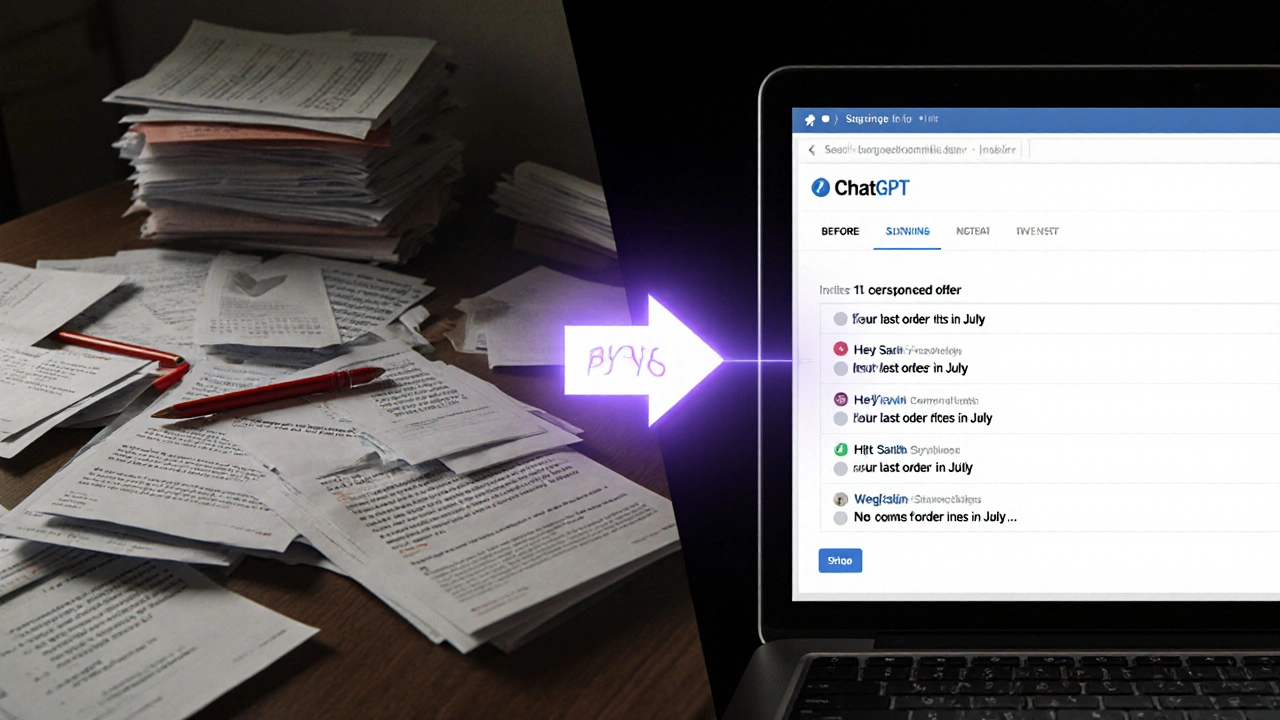Back in 2023, marketers were still figuring out if ChatGPT was a fancy toy or a real tool. Now, in late 2025, it’s the quiet engine behind half the campaigns you see online. You don’t need to be a coder or a data scientist to use it. You just need to know what to ask.
ChatGPT Isn’t Replacing Marketers - It’s Speeding Them Up
Think of ChatGPT like a junior copywriter who never sleeps, never complains, and can draft 50 variations of a headline in 90 seconds. It doesn’t replace your strategy - it handles the grunt work. A Melbourne-based e-commerce brand we tracked last quarter cut their content production time by 68% just by using ChatGPT to generate product descriptions, email subject lines, and social captions. They still hired humans to tweak tone, check for brand voice, and approve final versions. But now, their team of three writers outputs what used to take six.
That’s the real shift: AI doesn’t steal jobs. It removes bottlenecks. The people who thrive now aren’t the ones who write the most. They’re the ones who ask the best questions.
Content Creation That Actually Works
Writing blog posts with ChatGPT used to feel like feeding a magic box and hoping for a unicorn. Now, it’s more like tuning a radio. You need the right frequency.
Here’s what works in 2025:
- Start with a clear brief: "Write a 600-word guide on how to choose a smart thermostat for Australian homeowners, targeting people aged 35-55, with a friendly but authoritative tone. Include three real-life cost-saving examples from Melbourne suburbs."
- Feed it your best-performing past content as reference - paste in a top-performing blog post and say, "Write a new version in the same style but updated for 2025 energy rebate rules."
- Use it for structure, not final copy: Ask for an outline first. Then ask for section drafts. Then refine. Never accept the first output.
One agency in Sydney used this method to scale their content from 8 blogs a month to 32 - without hiring anyone. Their organic traffic grew 140% in six months. The secret? They didn’t let ChatGPT write the whole thing. They used it to draft, then added local insights, real customer quotes, and updated data from Energy Safe Victoria.
Email Marketing That Feels Human
Email open rates have been dropping since 2022. But brands using ChatGPT to personalize subject lines and body copy are seeing 30-45% higher opens and click-throughs.
Here’s how:
- Instead of "Hi there, check out our sale!", try: "Hey Sarah, your last order was in July - here’s what’s new for your dog’s dry food (and why it’s 12% cheaper now)."
- Use ChatGPT to analyze past customer behavior: "Based on this purchase history, write a follow-up email for someone who bought a yoga mat but never bought blocks or straps."
- Test 10 subject lines at once. Let ChatGPT generate them. Pick the top 3. Run A/B tests.
One small business in Adelaide saw their email revenue jump 22% in three months just by switching from generic blasts to these hyper-personalized nudges. The tool didn’t write the message - it helped them sound like they remembered their customers’ names, preferences, and buying habits.

Ads That Don’t Feel Like Ads
Facebook and Google ads are getting harder to make stand out. Everyone’s using the same stock photos and buzzwords: "limited time," "revolutionary," "game-changer."
ChatGPT helps break the noise by generating ad copy that sounds like real people talking.
Try this prompt:
"Write five Facebook ad variations for a local Melbourne plumber who fixes burst pipes. Use the voice of a stressed homeowner at 2 a.m. who just woke up to a flooded kitchen. No jargon. No hype. Just real panic and relief."
One plumbing company used this approach. Their click-through rate jumped from 1.2% to 3.8%. Why? Because the ads didn’t sound like ads. They sounded like a friend texting: "Mate, my kitchen’s underwater. You free tonight?"
Customer Service That Doesn’t Suck
Most chatbots are frustrating. They answer questions you didn’t ask. They loop you in circles. ChatGPT-powered support is different because it understands context.
Here’s what’s working:
- Training ChatGPT on your FAQ documents and past support tickets so it knows your product inside out.
- Using it to draft replies - not send them automatically. A human reviews and sends. This cuts response time from 12 hours to 15 minutes.
- Letting it handle the first wave of complaints: "I didn’t get my order" → ChatGPT checks tracking, suggests solutions, and offers a discount code if needed.
A SaaS company in Brisbane reduced their support tickets by 40% in four months. Their customers said they felt heard. Not processed.

What Not to Do With ChatGPT
It’s not magic. And it’s not perfect.
Here are the mistakes people still make:
- Using it to write SEO blogs with zero original research. Google’s 2025 updates punish thin, AI-generated content. If your article doesn’t have real data, quotes, or local insight, it’ll vanish.
- Letting it write your brand voice. ChatGPT doesn’t know your brand. You do. Always edit for tone, humor, and personality.
- Using it for legal or financial advice. It hallucinates. Always verify facts - especially tax rules, privacy policies, or compliance stuff.
- Believing it understands culture. A joke that works in the U.S. might offend in Australia. Always run output past someone local.
How to Start Using ChatGPT in Your Marketing - Right Now
You don’t need a big budget or a tech team. Here’s your 7-day plan:
- Day 1: Pick one task you hate - maybe writing product descriptions. Use ChatGPT to generate 10 versions. Pick your favorite. Edit it.
- Day 2: Ask it to rewrite your top-performing email subject line 5 ways. Test one.
- Day 3: Feed it three customer reviews. Ask: "What are the top three things customers love about our product?" Use that for your next ad.
- Day 4: Use it to brainstorm 20 blog ideas based on your most common customer questions.
- Day 5: Ask: "What’s one thing our competitors are doing that we’re not?" Look it up. Try it.
- Day 6: Set up a simple workflow: ChatGPT drafts → You edit → You send.
- Day 7: Measure. Did it save time? Did engagement go up? If yes, keep going.
That’s it. No apps. No subscriptions. Just you, your brain, and a free tool.
ChatGPT Is Just a Tool. Strategy Still Matters
The best marketers in 2025 aren’t the ones using AI the most. They’re the ones using it the smartest.
AI doesn’t replace vision. It amplifies it.
If you don’t know who your customer is, ChatGPT won’t fix that.
If you don’t know what message matters, it won’t create one.
But if you’ve got clarity - on your audience, your goals, your brand - then ChatGPT becomes your most powerful assistant. It handles the repetition. It scales the effort. It gives you back time to think, to test, to be creative.
The future of digital marketing isn’t human vs. machine. It’s human with machine.
Can ChatGPT replace my content team?
No. ChatGPT can draft content, generate ideas, and handle repetitive tasks - but it can’t replace human judgment, emotional intelligence, or brand understanding. The best results come from teams that use ChatGPT to speed up their work, then add their own insight, tone, and local context. Think of it as a co-writer, not a replacement.
Is ChatGPT good for SEO?
Only if used correctly. Google’s 2025 updates prioritize content with real expertise, experience, and original insight. ChatGPT can help you write faster, but if your article just rewrites existing info without adding new data, customer stories, or local details, it won’t rank. Always fact-check, add real examples, and edit for depth.
What’s the best way to use ChatGPT for social media?
Use it to brainstorm captions, suggest hashtags based on your niche, and rewrite generic posts into conversational ones. For example, ask: "Turn this product feature into a relatable Instagram caption for Australian parents." Always test different tones - funny, serious, or quirky - and track which ones get the most engagement.
Does ChatGPT understand Australian English?
It understands basic Australian spelling and slang, but it’s not perfect. Words like "thongs" (flip-flops) or "lollies" (candy) might be misinterpreted. Always run outputs past someone local. Ask it to adjust tone: "Rewrite this in Australian slang, but keep it professional." Then edit.
Can I use ChatGPT for email automation?
Yes - but don’t automate everything. Use it to draft personalized follow-ups based on customer behavior. For example: "Write a follow-up email for someone who bought a coffee grinder but hasn’t bought beans yet." Then have a person review and send it. This keeps automation human, not robotic.
Is ChatGPT free to use for marketing?
You can start with the free version, but for serious marketing, the paid version (ChatGPT Plus) is worth it. It’s faster, handles longer prompts, and has better memory for context. Plus, it’s less likely to hallucinate facts. If you’re using it daily, the $20/month cost pays for itself in saved time.
How do I stop ChatGPT from sounding generic?
Give it constraints. Tell it your audience, your tone, your brand voice. Use real examples: "Write like our CEO - direct, no fluff, uses phrases like 'get it done' and 'no nonsense.'" Feed it your best past content as a style guide. And always edit. The best AI output is the one you’ve made your own.





